By now, you should all be familiar with Project 337 and the symbolic significance this carries for local art and culture. If you were unable to make it to the exhibition before it was demolished, don’t despair8212;entrepreneurial filmmakers Alex Haworth and Davey Davis have got you covered. Through their production company, The Dada Factory, the two have released an informative and credible video documentary of the ephemeral gallery. Titled “Afterimage: The Art of 337,” the film is the next best thing to having seen the project in person.
The documentary is made up of a well-shot collection of interviews with artists, art absorbers and various local pundits, not to mention a montage of the actual artwork of 337. As a video record, the film utilizes these various sources to convey one general message8212;the overall awesomeness of the 337 Project.
The film’s strength is to be found in its production value. The full 70 minutes were shot in high definition on HVX (the independent filmmaker’s well-known weapon) with some creative camera work. The structure of the film telescopes the project’s culmination in the building’s demolition from a broad perspective to a more detailed examination of artist personalities and styles, and ends by returning to the building’s destruction. The film’s continual harping on the transitory nature of the gallery is one of its weaknesses. While undoubtedly an important facet of the project and an illuminating method for organizing scenes, the viewer is less than engrossed after the 30th mention of the building’s imminent demise and the quasi-Eastern mystic musings by its various pundits on the ramifications this event poses in terms of the inter-connectedness between creation and destruction.
Despite this philosophical faux pas, the film succeeds in nearly every other respect. Not bad for two U seniors whose involvement in the project was questioned by even the artists of 337 themselves.
“It was kind of funny there for a while because we were the guys just showing up with our cameras,” said Davis, one half of the Dada Factory. He recalled occasions when people wondered why anyone would even bother filming the grassroots artistic collaboration. “I was asked on a daily basis, “So, what are you filming this for?'”
Both of the cinematic startups placed the film in a relatable context by explaining the taxing time constraints on the schedule of full-time students who have rent to pay, grades to make and are invested in creating a quality feature-length film.
“There were definitely moments when we were like, “We’re not getting paid for this, it’s a total waste of time, it’s not a good idea to invest as much time as we are in it,'” Haworth said. “But as it went on, it became abundantly clear that we had done the right thing (by) sticking with the project.”
It was as clear as the aperture on a fixed-lens, high-definition piece of cinematic machinery in a film project, which ended up netting ten thousand dollars in grants from The Salt Lake Arts Center (through the Warhol Foundation) and Jones Waldo. The visionaries’ plans for the film’s future belied their shrewdness. Haworth sat in the production chair for a moment and explained how the film is best suited for television.
“I know that’s the route I want to go, as opposed to festivals. That way we could sell North American distribution rights for some money which would fund our next project,” he said.
Meanwhile, Davis expressed how, to some extent, other goals the two had for the film have already been accomplished.
“The University of Utah has a copy at the library. That for us is a tremendous success8212;more so than getting it into a film festival because that’s not our audience,” said Davis. “Our audience is the kids in this valley who are going to be inspired to make art because of seeing the project or seeing the film.”
Without trying to sound corny, perhaps that’s why Afterimage works so well. The Project 337 film is the result of a combined effort between the calculating intellectual drive of a film student and the idealistic pathos of a staunch admirer of Mondrian. More simply, it’s a fine film and everyone should be genuinely excited to see it as well as the Dada Factory’s next project.








